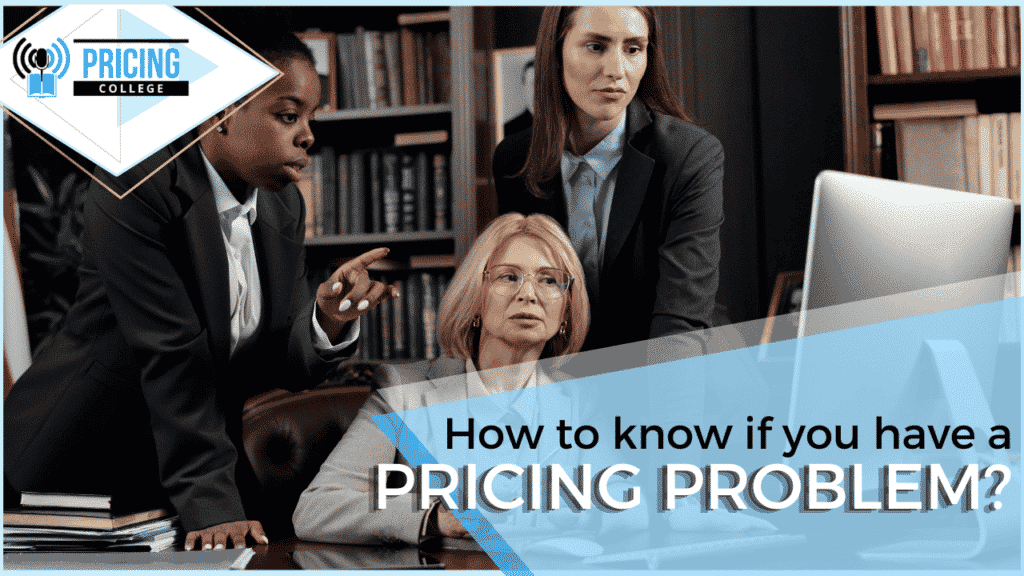
In this episode of Pricing College – we discuss how to know if your business has a pricing problem and what to look out for. Spotting a pricing problem early can save your business a great deal of heartache down the line.
Listen on Apple Podcasts Listen on Spotify Listen on Google Podcasts Listen on Stitcher Listen on Amazon Music
TIME-STAMPED SHOW NOTES:
[00:50] Joanna explains that business leaders often leave pricing to the end.
[01:15] Pricing is a lead indicator of future business success.
[01:50] On the Profit and Loss statement – is revenue increasing but profit decreasing?
[02:25] What does your sales team say?
[03:10] Does return on investment cover the cost of capital?
[03:50] Joanna introduces pricing power.
[04:20] Warren Buffett focuses on pricing power.
[05:00] Commodity mindset constrains pricing power.
[05:30] Private Equity is becoming more focused on pricing.
Strategic Team Planning For Pricing & Commercial Teams!
In today’s episode, we want to ask the question: how do you know when your business has a pricing problem?
It sounds like an easy question. But actually, it’s quite difficult to detect you’ve got a pricing problem. Often, business leaders think about pricing right at the very end because they don’t think it’s the problem. But it’s the cause and driver of a lot of other issues. So, I just wanted to discuss some of the things you should look out for and double-check to see if you’ve got a problem or not.
When we look at companies, a lot of them assume that they have a pricing problem. But one of the best reasons to do this in advance is to check if it’s a lead indicator of future business success. If your business is facing a pricing problem that will suggest that down the line, there will be a financial impact, then there will also be successful impacts. So, I think it’s almost a canary in the main concept where it gives you that lead indicator, whether they’re at six months or a year in advance.
Maybe you should always measure and look out for it as part of a general financial rigour and check if you’re on the right track. Now, one of the things you should probably look out for is on the P&L. The very basic sign is if your revenue is increasing but margins are declining. This is a good sign but potentially, you may have some pricing issues.
If you’re selling more and more but you haven’t reduced the pricing at all, this assumes that there’s no huge volume discounts or rebate strategies in play. But to sell more products, you’re gonna have to discount and reduce your margins. Another aspect of this can be more of a “people aspect” talk with your sales team. Then, see what they say.
They might be complaining that there’s a lot of pricing pressure out there, a lot of competition, and they’ve got no choice but to discount a lot of the products. That included even the high-value products more than they want to. In fact, it may often be the case.
It’s a simple sort of cost-plus pricing methodology that isn’t covering substantial price premiums that you could charge. Or, indeed it could be something that you’re struggling to cover the cost of CapEx, even though your sales teams are selling lots of deals and products. But you’re just not getting returns there.
I think, especially for more capital-intensive industries where you need your business to be the return on investment, it has to certainly cover the cost of the capital. Otherwise, you will eventually go broke. If you’re investing in a business that isn’t growing and doesn’t have pricing power sufficient to forecast, then it’s a ticking time bomb. It should give you good confidence in ongoing profitable growth that will cover the investment.
It’s good to think about your pricing power, so you’ll know what price-setting methodology you should use. But it’d be quite dangerous to apply value-based pricing in a margin constrained industry with limited pricing power. You need to think very carefully about your P&L and your price setting methodology.
I think when we talk about looking at a business and seeing what doesn’t have a pricing problem, the flip side of that is the opposite of a pricing problem is having pricing power. Like Warren Buffet, probably the world’s famous investor always talks about pricing power in businesses that he looks at. He looks at having protective moats and pricing power whereby that company can either maintain or increase pricing over a short-medium term.
It’s funny that sometimes if you just look at the P&L to determine your pricing power, you can think you don’t when you do. This is a sort of a mindset issue. We see a lot of companies that potentially have more pricing power than they think they do. But they’re constraining the power of pricing because they’ve got a commodity mindset.
There’s that sort of tricky line between looking too much at the P&L to determine pricing power. You have to think psychologically about the culture of the business and trying to unlock both – the mindset and the P&L.
We’re seeing proactive institutional investors, people like private equity. Classically, what they do is the buyer company takes on debt and then they try to improve the company through either cost-cutting or improving the commercial focus. And pricing is becoming much more common in that area whereby streamline did the business system well. It also improves the commercial and pricing approach and outcomes.
Private Equity is now staying in businesses much longer. They are growing the business and look at the pricing when they’re buying a company to see if there is indeed pricing pressure. Once they bought it, they want to grow their business. So, they’re introducing more sophisticated pricing techniques, value-based pricing, dynamic pricing, to ensure the return on investment.
We’ll wrap it here today. But what I’d like to finish on is that having a pricing problem is not always a bad thing. Spotting a problem is the first step of fixing it. Then, knowing you have a problem that just tells you, you can improve.
That’s right. When you think everything’s okay or you don’t have a check-in place to make sure things are on track, then ask those questions. Look at the P&L, and look at the behaviour of your team. This will give you a sense of where you’re at with pricing and never underestimate your pricing power. Think about mindset, P&L, and team behaviour.
LINKS MENTIONED IN TODAY’S EPISODE:
Warren Buffett and pricing power.
For a comprehensive view on building a great pricing team to prevent loss in revenue,
Download a complimentary whitepaper on How to Build Hiring Capability To Get The Best Pricing Team

